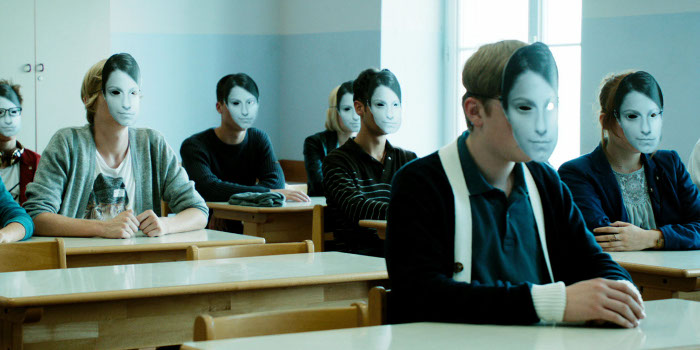Editor’s Notes: The following capsule reviews are part of our coverage of the 2014 Vancouver International Film Festival. For more information on the festival visit viff.org and follow VIFF on Twitter at @viffest.
Class Enemy
Dir. Rok Bicek
Bicek’s Class Enemy is a powerful film about grief, authority, social politics and educational practice. With its incident occurring in modern Slovenia, the film comments on rising new ways of thinking in a place accustomed to old world traditions. Traditional forms of discipline and punishment are being abandoned, but when a new teacher with old values substitutes a class, traditional forms of discipline and punishment are put starkly against the emerging new world of open door politics. The film thus becomes a metaphor of a changing Slovenia, with the teacher representing the authority keeping the masses—students—at bay.
When a young, distraught girl commits suicide, the students are quick to blame the authority figure, their new substitute teacher, for his dictatorial reign in the classroom. It’s presented that Sabina experienced much pain in her life, but in spite of this, the class blames the teacher for pushing her too hard. Several students take it upon themselves to expose him; at one point, they take over the school radio and berate him over the airwaves. What’s especially appealing about all this, and the script at large, is that the characters are not stereotypes. They are individuals and they are treated by Bicek with respect. The film is as much a character study as anything else, with much attention paid on how each student responds to Sabina’s troubling incident.
The film is rather poetic at times. Use of a hand camera and a telephoto lens helps to create tense close-ups and long moving takes that distort one’s sense of realism. This distortion of reality speaks to the distortions found in social practice which are conceptually forward in the film.
Class Enemy ends with a metaphysical gesture: Sabina walks around the students on their leaver’s trip. In a hand operated movement, a long take leads the viewer through a weave of students only to stop before the slipstream behind the boat. The rushing water metaphorically expresses the film’s conclusion of leaving the past behind, and of moving forwards into the new world.
Men Who Save the World
Dir. Seng Tat Liew
In this bizarre, outlandish, and somewhat absurd comedy about ignorance and superstition in a small village, a group of misinformed individuals take ridiculous measures to save themselves and the world from what are ironically their own misdeeds. Due to miscommunication and bad timing, naïve men come to certain dumb beliefs which then guide them on a path to righteousness. This path, of course, leads nowhere.
Though outlandishness is a form of comedy, serving this film throughout each scene, it’s a form of comedy that it often annoying or obnoxious, especially when there is no deeper substance to the jokes. It’s an extreme and exaggerated form of humour that works well to make certain ironic or sardonic remarks, but this film has no deeper substance. Instead, the film appears insubstantial; its ridiculousness becomes irritating. Though beautiful and funny at times, Men Who Save the World is easily forgettable and likely not worthy of a revisit.
Gente de bien
Dir. Franco Lolli
A film about isolation and class disparity, Gente de bien chronicles the life of a confused young boy lost in the middle of social hierarchies and gentrification. Living with his estranged father after his mother leaves, the boy develops a kind of borderline personality disorder. Feeling abandoned, he rejects his father who seems to represent all the negative forces surrounding him: he’s poor, unambitious, and low class.
Not knowing his place, the boy pushes people away with his rude and aggressive behaviour. Not only his potential friends, he pushes away a woman who kindly takes him into her home. He really only cares about his dog, since his dog loves him unconditionally. When the dog must be put down, he cries in the realization that he can’t always have what he wants. The boy and father walk away a little humbled from their experiences.
The film is shot conventionally for the most part, though the creatively smoky mise-en-scene is quite interesting. That said, the formal style and direction of Gente de bien is overall quite scattered. It serves in shoring up a bleak image of society with citizens as scattered victims of social injustice.
Mercedes Sosa: Voice of Latin America
Dir. Rodrigo H. Villa
A documentary about a relatively unknown singer who was supposedly the voice of a generation, Mercedes Sosa: Voice of Latin America is entertaining and draws interest but is also highly contrived. With much said about her amazing talents and effect on Latin America at large, it is difficult to believe or buy into it all. Though it is a film about a singer, the director uses this as a jumping off point to talk about Latin America. He does this with the presumption that she was a public figure whose life paralleled the changes in Latin America because her hardships and experiences were so profound that they were somehow inextricably bound to Latin America as a whole. This entire presumption seems unsound, and though the film uses many examples to support its thesis, these examples are not always convincing. For example, comparing her banning to Latin America’s policies on banning seems rather incomplete.
Besides this social impetus, music from her career is shown throughout the film. It indexes and punctuates the chronologically told story which mostly uses the expository mode of documentary filmmaking. Formally, there are some examples of Cinema Verite, and superimpositions are used heavily, presumably to ensure that the audience understands that she wasn’t just a single person but that her life was enmeshed with everything, absolutely everything, in Latin America at the time. Overall, the music is enjoyable and the way in which Villa has paralleled her with Latin America is interesting, but the scope of the film is a little too unbelievable and contrived to be taken seriously.
Still Life
Dir. Uberto Pasolini
While Still Life is not exactly an example of minimalism in film, the mise-en-scene, rhythm, and visual language speak to certain qualities of minimalism. The central character, John May (Eddie Marsan), who is highly meticulous, thorough, exacting, and restrained, brings forward these qualities of the minimal, of the accentuated, and, when done correctly, the poignant.
Much dry and dark comedy abounds when John May searches for the family and friends of a deceased man. He strongly believes that everyone deserves a funeral where friends and family can mourn them. In his work, however, he has little been able to accomplish this. In most cases, he wastes time and then the body is cremated. To speed up the process, he has been fired and the search for loved ones will no longer be an operation at his company. He pleads to have just one more case.
The film carries a very melancholic tone, which is complemented by stillness, silence, and a grey colour palette. Throughout, we see John May continue with his banal meanderings and wonder what the purpose of it all is. Until the end, we don’t appreciate just what an amazing man he is. In a profound and highly poignant final scene—one of the best of the year—John May receives his own funeral, attended to by all those he helped along the way.







Pingback: yellow october()
Pingback: clash of clans hack()
Pingback: randy()
Pingback: clash of clan online()
Pingback: Francis()